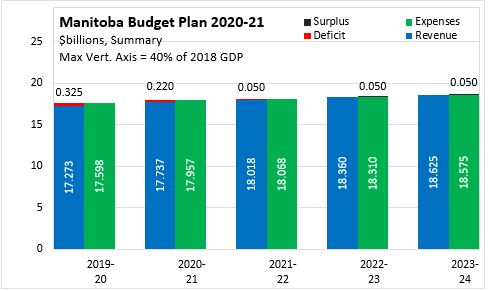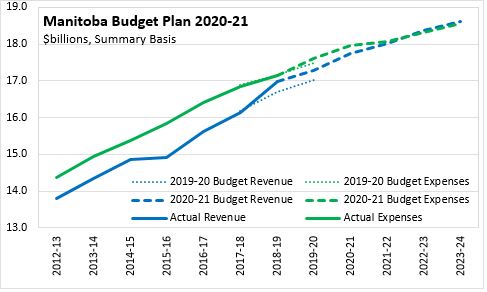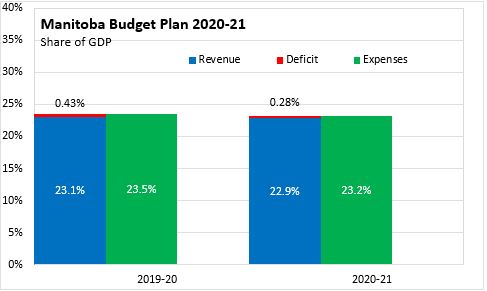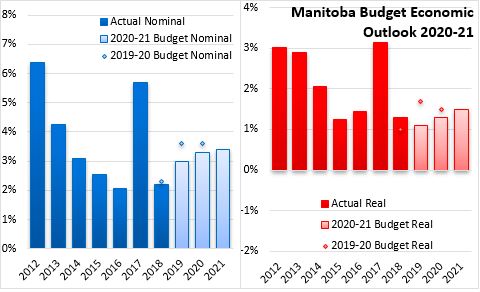The Economics and Statistics Division maintains archives of previous publications for accountability purposes, but makes no updates to keep these documents current with the latest data revisions from Statistics Canada. As a result, information in older documents may not be accurate. Please exercise caution when referring to older documents. For the latest information and historical data, please contact the individual listed to the right.
<--- Return to Archive
For additional information relating to this article, please contact:
March 23, 2020MANITOBA BUDGET 2020-21 The province of Manitoba's Budget was originally scheduled for release on March 11, 2020. Delays in the Manitoba Legislative Assembly prevented tabling of the Budget on schedule. The Budget documents were posted on March 19, 2020 with an emergency supplement that addresssed the COVID-19 outbreak.
The Budgetary information reported below constitutes the foundation assumptions made prior to the sudden escalation of health, economic, financial and social impacts from COVID-19. The emergency supplement to the Budget estimates that Budgetary expenditures will be higher than those developed for the March 11, 2020 Budget and that Budgetary revenues will be affected by a recession and turmoil in oil markets. The Manitoba estimated impact of COVID-19 assumes that the economy declines in the first three quarters of 2020 before returning to positive growth in Q4.
In the March 11, 2020 Budget assumptions, Manitoba's deficit was projected to decline from $325 million in 2019-20 to $220 million in 2020-21. In an accompanying plan for Fiscally Responsible Outcomes and Economic Growth Strategy, the Manitoba government indicates that it intends to return to surplus by the 2022-23 and 2023-24 fiscal years with a surplus of $50 million in each year. Between 2019-20 and 2023-24, revenue growth is projected to average 1.9 per cent per year while expenditures grow by 1.4 per cent per year.
The 2020-21 Budget ends the practice of incorporating a "lapse" assumption of expenditure reductions not yet identified, but required to meet the expenditure target. The Budget includes provisions to add $300 million to the Rainy Day Fund between 2019-20 and 2020-21.

Compared with the fiscal plan from the 2019-20 Budget, revenues are projected to be notably higher while expenditures remain only slightly above prior plans. The return to surplus anticipates slower expenditure growth starting in 2021-22 to bring expenditures in line with projected revenue growth.

The Manitoba Public Accounts reported a smaller than expected deficit for 2018-19. The March 11, 2020 Budget assumption indicated that deficits would be somewhat narrower than anticipated in the 2019-20 Budget projections, but following a similar path back to balance.

Manitoba's planned government expenditures in 2020-21 amounted to 23.2 per cent of GDP while revenues were 22.9 per cent of GDP. The deficit planned in the March 11, 2020 Budget amounted to 0.3 per cent of GDP. For 2020-21, Manitoba's net debt-to-GDP ratio is forecast to be 34.2 per cent.

The March 11, 2020 Manitoba Budget projected slower GDP growth than previously projected for 2019 and 2020. Economic growth was projected to rebound to 1.3 per cent real GDP growth for 2020 and to 1.5 per cent for 2021. GDP growth is projected at 3.3 per cent in nominal terms for 2020 asnd 3.4 epr cent for 2021. Manitoba's near term economic growth assumptions were based on strong residential construction to support a rising population as well as business investment. The near term risks identified in Manitoba's Budget were focused on trade tensions. The Budget noted that Manitoba economic assumptions have generally been more optimistic than actual GDP growth reported by Statistics Canada.

Key Measures and Initiatives
Manitoba's government is continuing with substantial tax measures, along with a revised approach to fiscal planning. Key tax measures include:
- Reducing the retail sales tax from 7 per cent to 6 per cent on July 1, 2020
- Making manufacturing investment tax credit permanent and extending mineral exploration, cultural industries printing and comunity enterprise development tax credits.
- Implementing the Green Levy ($25 per tonne of carbon dioxide/equivalent) effective July 1, 2020
Manitoba Budget 2020-21
<--- Return to Archive